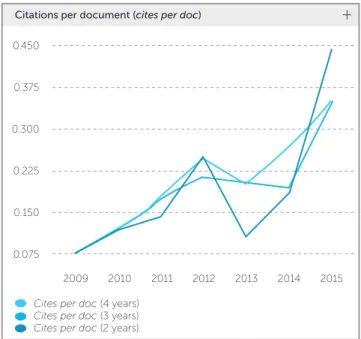© 2016 Dental Press Journal of Orthodontics 12 Dental Press J Orthod. 2016 July-Aug;21(4):12-3
edito
rial
Every year, in June, the major databases publish the impact exerted by scientiic periodicals in the scientiic context. While Thompson Reuters quantiies it as the journal’s impact factor, SCImago database terms it cites per doc. However, both estimate the average number of citations of articles published in a certain periodical. The methods are very similar, with the only diference being the number of periodicals indexed in each database.
Recently, in June 2016, data on the citations made in 2015 were published. The number of citations made in 2015 for articles published in 2013 and 2014 was divided by the total number of articles published in 2013 and 2014. Therefore, an impact factor of 2, for a certain periodical, means that, for every article published in 2013 and 2014, there was, on average, two citations of such articles in 2015.
Despite criticism received by such bibliometrics, those evaluation systems have been widely used to as-sess the importance of a given periodical within its ield of expertise. Overall, the more oten a recently published article is cited, the greater its impact in the scientiic context. Although it has expanded, Den-tistry is not among the most impacting ields. While our best-ranked dental periodicals are near the aver-age of having ive citations per article, in Medical Sci-ences and Physics, a few periodicals have exceeded the
number of 40 citations per article published. In Den-tistry itself, specialties are heterogeneous. On one hand, our Periodontal periodicals have an average cites per doc of 5; on the other hand, in Orthodontics, Ameri-can Journal of Orthodontics and Dentofacial Orthopedics; Or-thodontics and Craniofacial Research and Angle Orthodontists presented cites per doc varying between 1.66 and 1.62, according to data provided in 2015.
Dental Press Journal of Orthodontics (DPJO), in-dexed in SCImago Scopus database, received its irst cites per doc in 2009, when the journal was published in Portuguese only. As from 2010, DPJO articles began to be published in English. Since then, our impact in-dex kept increasing and reached 0.25 in 2012 (Fig 1). At that point, there was an avalanche of good publi-cations, and, in 2013, a setback was rendered neces-sary, as a consequence of having to double the num-ber of articles published, so as to speed the publication
process up.1 Such change increased signiicantly this
equation denominator. Ater all necessary adjustments were made, in 2014, DPJO recovered part of its cites per doc loss from 2013.
Last June, we received data on the citations made in 2015, and found out we had an index equal to 0.44, a threefold increase in comparison to the previ-ous year. There are two main reasons to warrant such
How to cite: Normando D. Science and impact: the challenge faced by Dental Press Journal of Orthodontics. Dental Press J Orthod. 2016
July-Aug;21(4):12-3. DOI: http://dx.doi.org/10.1590/2177-6709.21.4.012-013.edt
DOI: http://dx.doi.org/10.1590/2177-6709.21.4.012-013.edt
1 Adjunct professor, Universidade Federal do Pará (UFPA), School of Dentistry, Belém, Pará, Brazil. Coordinator, Universidade Federal do Pará (UFPA), Graduate
program in Dentistry, and ABO-Pará, Specialization course in Orthodontics, Belém, Pará, Brazil. David Normando1
Science and impact: the challenge faced by Dental Press
Journal of Orthodontics
© 2016 Dental Press Journal of Orthodontics 13 Dental Press J Orthod. 2016 July-Aug;21(4):12-3
Editorial
more accessible. This indexation increased the chanc-es of citation, thereby also increasing the equation numerator. Therefore, we went from 54 citations in 2012, before being indexed in PubMed, to 130 cita-tions in 2015 (Fig 2).
We have grown signiicantly; however, a lot more is yet to be reached. For the index to be determined in 2017, based on data from 2016, the equation denomi-nator (number of articles published in 2014 and 2015) will be decreased by 20%. Additionally, it is hoped that the number of citations will increase, especially due to the periodical being indexed in PubMed Central. This database provides full, free access to all articles published from 2014 onwards, on the following web-site: www.ncbi.nlm.nih.gov/pmc/journals/2644. If we consider a potential decrease of 20% in the equation denominator and an increase of 80% in the equation numerator, we believe that we will be able to double DPJO’s cites per doc in 2017 and reach a number close to 1.0. Should this be fulilled, DPJO will become one of the six periodicals exerting the greatest impact in world-wide Orthodontics. If there once were so many stones in the middle of the road, many of them have already been removed, while some are yet to be.
David Normando - editor-in-chief (davidnormando@hotmail.com)
1. Normando D. Dental Press Journal of Orthodontics and QUALIS. Dental Press J Orthod. 2015 Sept-Oct;20(5):12-3.
REFERENCES
signiicant growth. The irst is the adjustment made to publication low, reducing the time interval between manuscript submission and publication, and, most of all, having a smaller number of more selective articles published: while in 2013, 138 articles were published, in 2014 and 2015, 101 and 92 articles were published, respectively. Thus, we have been reducing the equa-tion denominator. The second reason was having DPJO indexed in PubMed database in 2013, thus rendering knowledge published by this periodical
Self-cites
Total cites +
2009 140
70
0
2010 2011 2012 2013 2014 2015
Figure 2 - Dental Press Journal of Orthodontics total number of citations (total cites) and self-citations (self-cites) between 2009 and 2015.
Citations per document (cites per doc) +
2009
Cites per doc (4 years) Cites per doc (3 years) Cites per doc (2 years)
2010 2011 2012 2013 2014 2015
Figure 1 - Dental Press Journal of Orthodontics cites per doc between 2009 and 2015.
0.450
0.300
0.150 0.375
0.225
